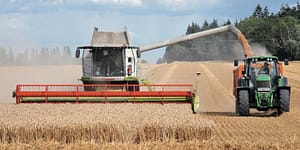CARBON CASCADES: How to Restore Earth’s Natural Balance

In order to rescue ourselves from climate catastrophe, we need to radically alter how humans live on Earth. We have to go from spending carbon to banking it.
A secret unlocked by the ancients of the Amazon for its ability to transform impoverished tropical soils into terra preta—fertile black earths—points the way. The indigenous custom of converting organic materials into long-lasting carbon has enjoyed a reawakening in recent decades as the quest for more sustainable farming methods has grown. Yet the benefits of this carbonized material, now called biochar, extend far beyond the soil. Pyrolyzing carbon has the power to restore a natural balance by unmining the coal and undrilling the oil and gas. Employed to its full potential, it can run the carbon cycle in reverse and remake Earth as a garden planet.
The following excerpt is from BURN by Albert Bates and Kathleen Draper. It has been adapted for the web.
What you people call your natural resources, our people call our relatives.
—Oren Lyons, Haudeneshaunee
Long tail is a term used to describe the residual earnings that come from an asset after it has had its initial market impact. In the case of a book like the one you are holding, the long tail might begin as a magazine series; move to ebooks, audiobooks, webinars, and films; and then pass along to a very long and fruitful second life in foreign translations and excerpted reprints.
Managed well, most forms of carbon can have very long tails. As labile carbon from photosynthesis, the tail moves from the soil food web and the exudates of fungi and bacteria into the roots, stems, and leaves of plants, or, in the case of marine life, from the nutrients brought to surface by whales to feed ocean gardens of algae and plankton. Some of this nutrient flow is consumed by animals and passed up a food chain until the organisms reach the end of their lives, die, and the carbon is returned to cycle around once again. There is no end destination, just a continuous cycle.

But wait, as they say, there’s more. The more we rebalance the carbon cycle, the more we can lengthen its tail; in fact, the cascades amplify themselves, beyond what could even be described with a linear metaphor, and into a deeply circular one. Instead of the three-stone fire common in much of the world, perhaps the cook is a proud owner of a BioLite stove. The stove captures the heat during cooking and converts a portion to electricity to charge the family phone and/or provide home lighting. Maybe the cook doesn’t need to go looking for twigs anymore because the same village cooperative that sold her the stove also planted fast-growing moringa trees and harvests not only the fuelwood but also the nutritious leaves, medicinal bark, and high-protein seedpods. And perhaps instead of adding the biochar to the compost pile, the family first uses it to filter their drinking water and then deodorize their bathroom before sprinkling it into the dry latrine where it removes odors and later makes an even better compost accelerator. Or perhaps the biochar is taken from the stove, ground into powder, and mixed with cattle feed, where it accelerates the growth of calves, raises milk production, and keeps the animals healthier. The animals deposit their biochar-containing manure in the pasture where it is taken underground by dung beetles, or in the barn where it is collected for fertilizer, and traded to a cooperative to speed the proliferation of the moringa trees.
In economic parlance, these cascading uses would be called multipliers. The more transactions, and the faster they occur, the more rapidly the standard of living of all the participants in the local economy grows. As the benefit of the captured carbon cascades throughout the system, there’s also a cascading social impact. The two are, in fact, indivisible. Compare this with our current extractive linear model: The tail of coal, oil, and gas winds through exploration, test drilling, removal, refining, distribution, retail sales, burning for end use, and solid, liquid, and gaseous emissions, and ends in a contamination cascade of the soil, oceans, and atmosphere. There, but for the lethal legacy of climate change and latent cancers from inhaled or ingested toxins, the story of fossilized carbon typically ends. There is a branch tail that extends farther and lasts a bit longer. It winds from the refineries through petrochemicals to a wide variety of short-lived or long-lived products (e.g., plastics), employing a very large number of people along the way, before coming to rest, as did the main branch, in pollution of one type or another, possibly in the carcasses of billions of marine creatures.
Let’s take another example: In Stockholm, Sweden, through years of trial, error, and persuasion, a small but dedicated team succeeded in building a strong, consistent, nonseasonal demand for biochar. Having proved the various benefits of using biochar in structured soils—one part biochar, one part compost, to six parts gravel by volume—the city found itself unable to meet its own demand. It had to import biochar from vendors in the United Kingdom and Germany by the boatload for the growing number of urban projects. That created an opportunity.
The Stockholm team first focused on improving urban tree survivability. As they expected, the trees and shrubs they planted in biochar-augmented soils thrived compared with trees in heavily compacted soils. Urban trees provide services estimated at more than $500 million for a city the size of Stockholm, including improved air quality and human health, production of oxygen, carbon capture and storage, wildlife habitat, reduced heat island effect, reduced energy demand, and improved property values. When Stockholm gets a heat wave, drought, plague of bark beetles, or deep winter freeze, its trees can now more easily survive. Not having to replace urban trees after each natural disaster represents an enormous cost savings to taxpayers.
Stockholm discovered an unintended but enormously valuable cobenefit. Switching to gravel-based, biochar-enhanced structured soils for urban landscaping provided a significant reduction in both the volume and contamination of stormwater going to the city’s wastewater management system. That reduced municipal wastewater management costs. After winning the 2014 Bloomberg Mayor’s Challenge—a competition for cities to come up with solutions to major urban challenges that can be adopted by other cities—Stockholm took the next step in creating a closed-loop, waste-to-biochar-plus-energy-production facility to eliminate the need to import biochar and upcycle urban green waste.
Simply to recycle is not enough, because that is usually a downward spiral through less valuable and less complex products to final disposal. When we speak of upcycling, we borrow that word from architect William McDonough and chemist Michael Braungart, authors of Cradle to Cradle: Remaking the Way We Make Things.1 Upcycling is about the biological design of industrial processes, endowing each with its own metabolism, and collectively giving all processes and products the ability to function as ecosystems. Regenerative system theorist Daniel Christian Wahl says that being able to do this successfully is the first, important step toward creating regenerative cultures.2
Opportunities for carbon cascades abound. Enormous amounts of water are used to process food. Grocers need it to remove dirt, leaves, skin, and seeds from fresh produce. Processors need water for blanching, cooking, cooling, and cleanup. Beverage producers use it for mixing, fermentation, cooking, cooling, and bottling. All too often the effluent is disposed of untreated into nearby soils or water bodies. Though there are few contaminants and often plenty of nutrients, as untreated waste it can be toxic to aquatic ecosystems. Biochar can be used to harvest these nutrients while recovering the water for reuse, and then the nutrient-laden char can be used to grow crops, regrow forests, or regreen deserts.
A filtration-to-fertilizer (F2F) strategy has been explored in a joint research project of the Ithaka Institute for Carbon Intelligence, Rochester Institute of Technology, and Cornell University. Various biochars have been tested to filter wastewater from tofu, beer, and dairy whey. Early results show biochar reduces suspended solids and chemical oxygen demand while improving the pH in the effluents. Greenhouse trials using biochar filled with the nutrients from tofu production effluent showed that adding only 5 percent to potting mixes significantly boosted yields: 38 percent for lettuce and 62 percent for basil.
Currently many tofu, cheese, and yogurt manufacturers send tanks full of highly acidic whey to nearby farmers who spray it on fields as a low-cost disposal strategy. Let’s reimagine that harmful scenario transformed by a beneficial carbon cascade: Farmers lease carbonized crop residues to these manufacturers, then recover the saturated and enriched char to use as a slow-release fertilizer. This could lower the cost of water and wastewater treatment for the tofu, cheese, or yogurt maker, boost the bottom line for farmers, and prevent soil acidification.
This type of cascade can displace what is often done with activated carbon used for filtration. Because of its high cost, saturated activated carbon is often shipped off to be reactivated using high-temperature thermal processes that purge residues but burn off some of the original carbon at the same time. While regeneration creates fewer greenhouse gases than making activated carbon from scratch, the F2F approach eliminates the need for reactivation energy, reduces transportation miles, and reduces the need for fertilizer, which carries its own heavy carbon footprint.
All of this is well and good, you might say, but it sounds a bit like fairy dust. Maybe practical in small, isolated pockets of society, but is it really workable to address a crisis of planetary proportions? How do we avoid the dangerous consequences that characterize so many negative emissions technologies? Could it ever be economically viable? And where do we even begin?

Recent Articles
Oxeye daisies are one of the most important plants for pollinators including beetles, ants, and moths that use oxeye daisies as a source of pollen and nectar. Instead of thinking about removing a plant like oxeye daisy, consider how you can improve the fertility and diversity of habitat resources in your home landscape, garden, or…
Read MoreIn her book, The Art of Science and Grazing, nationally known grazing consultant Sarah Flack identifies the key principles and practices necessary for farmers to design, and manage, successful grazing systems. This book is an essential guide for ruminant farmers who want to crate grazing systems that meet the needs of their livestock, pasture plants,…
Read MoreThis long-lived perennial legume is used for forage and erosion control. Kudzu is edible with many medicinal uses and other applications. Pollinators of all kinds love its prodigious lavender blooms!
Read MoreMove aside, maple! We have two new syrups to add to the table. Read on for insights on tapping, selling, and eating syrup from walnut & birch trees.
Read MoreWhy is modern wheat making us sick? That’s the question posed by author Eli Rogosa in Restoring Heritage Grains. Wheat is the most widely grown crop on our planet, yet industrial breeders have transformed this ancient staff of life into a commodity of yield and profit—witness the increase in gluten intolerance and ‘wheat belly’. Modern…
Read More









